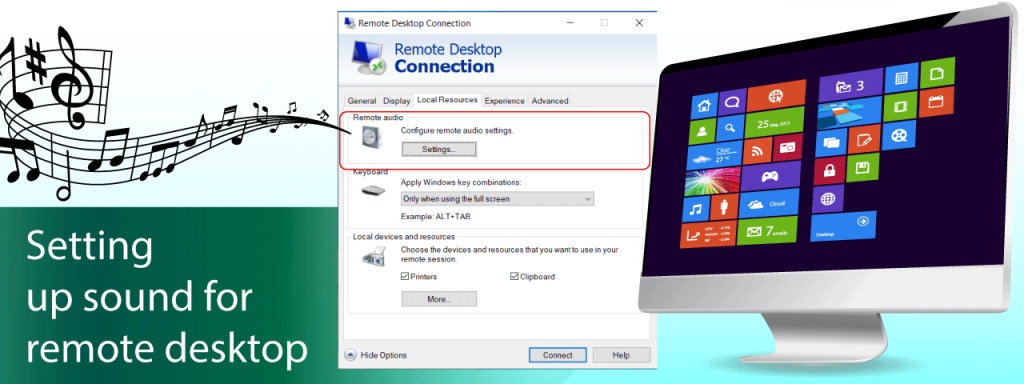Setting up sound for remote desktop
Remote work is becoming increasingly popular in the modern world. Thanks to unique technologies, employees can perform their duties from anywhere in the world. High-quality sound is essential for video calls and conferences. We will tell you about all the features of setting up sound for the remote desktop and what to do if the remote desktop sound not working. Our guide will provide instructions for setting up the technology and some tips that will help significantly improve efficiency.
Understanding Remote Desktop Sound
First, it’s worth understanding what remote desktop sound is. It is a unique program that provides audio communication between the administrator and the user’s computer. The remote user can connect to the microphone, headphones, or other devices there as if they were directly connected to his laptop.
When using remote desktop audio, the administrator can control all audio settings. This allows you to create the most comfortable sound for all participants in the audio meeting, while only the user can control them when connected locally.
It is worth noting that using remote desktop sound allows you to avoid many cords in the work area. In addition, the company does not need to provide additional devices for employees, which avoids additional waste. Remote desktop sound technology can also be used to hold conferences with partners and present products to clients.
Configuring Sound for Remote Desktop Access
Correct remote desktop sound settings will help avoid most problems and create comfortable conditions for all conference participants. First, you need to enable remote access on the administrator’s computer. To do this, press Win + X, select the System tab, and go to the Remote Access tab. You must allow the connection and confirm the action.
On the remote computer, you also need to press Win + X and type «mstsc» to search for the remote desktop. Then you need:
- open the Remote Desktop window;
- go to the Remote Resources tab;
- select Remote audio;
- open Settings;
- In the Remote audio playback tab, select «This computer»;
- then you need to click OK to save the changes.
You can also record audio files if needed. Just select the appropriate button in the “Record remote audio” window.
Now, you can enable sound on a remote desktop. To do this, make it as simple as possible. Go to the remote desktop program and click on the connect button.
If there is no sound on the remote desktop, it is worth checking the relevance of the drivers and sound settings on the remote computer and the compatibility of all operating systems.
If there is audio delay or interference, gently check the stability of the network connection. This problem may occur due to low download speeds or heavy load, especially if many people are using remote access simultaneously. In this case, it is worth changing the audio stream settings or router.
Security Considerations in Remote Desktop Sound
Users often concern themselves with security when using remote desktop audio. Highfigure uses multi-level encryption to protect data transmission, reducing hacking attempts and information leakage to zero. Using our products, you can control who is using the devices and restrict user access if necessary.
You should regularly check for updates to increase the security of the technology. New versions are more secure and have additional security features, making meetings as secure as possible.
You can use complex passwords to connect to remote access to enhance security. You can use login confirmation using one-time passwords.
Enhancing Sound Performance in Remote Desktop Environments
High-quality sound will improve conferences and product presentations. We have prepared several tips to help you quickly understand the settings. Choose the minimum compression to compress the sound. It will avoid delays and distortions.
Low connection speeds may cause a remote desktop sound delay. This can be avoided by using additional routers or other equipment that prioritizes audio files.
You can use additional programs to improve the sound quality of your remote desktop. For example, Zoom or Microsoft Teams can deliver better audio quality than built-in remote access programs.
You can also use special programs to monitor and control sound. For example:
- Audio Relay. Transfers the audio stream to a better remote desktop sound quality.
- Performance Monitor. Monitors CPU, memory and network load levels.
- LatencyMon. It helps determine the cause of remote desktop audio latency.
Keeping your software and drivers up to date will help you maintain optimal remote desktop audio levels. Regular tuning allows you to find better sound even when the network is heavily loaded.
Best Practices and Tips for Remote Desktop Sound
A good headset would help You get high-quality sound from a remote desk. It doesn’t just apply to headphones and microphones. An external sound card will help create clearer, lag-free sound.
Set the quality to the maximum value in the settings if your network connection allows. If not, with these parameters, the audio track freezes; setting the maximum permitted high value is better.
It is also worth checking network bandwidth regularly. Due to the large number of users, it can be significantly reduced, affecting the remote desktop’s sound quality. In this case, slightly lower the audio track settings and use compression.
Before each audio meeting, it is worth testing the sound of the remote table. It allows problems to be corrected before the conference begins. You can use both built-in programs and additional equipment to do this.
Quality audio plays a huge role in team productivity and collaboration. Using remote access technology, you can organize meetings with partners and employees from the most remote corners of the world. Regular testing and installation of new software versions will allow you to maintain high productivity. Additional programs will be used to improve the sound quality and volume. It will help significantly enhance remote work.
